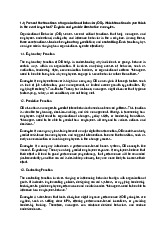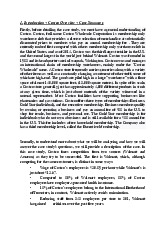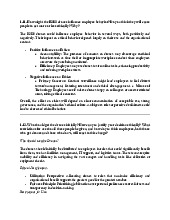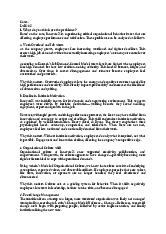








Preview text:
lOMoAR cPSD| 58591236
TRƯỜNG ĐẠI HỌC KINH TẾ QUỐC DÂN -------***------- ASSIGNMENT REPORT TRINH QUANG MINH Student ID: 11224322
Class: Quản trị marketing 64B
Lecturer: Ph.D. Nguyen Duc Kien Hanoi, 25th Oct 2024 lOMoAR cPSD| 58591236 INTRODUCTION
"A life without challenges is a life not worth living," as Socrates once said. Challenges are an
inevitable part of everyone's journey. However, what sets successful people apart from those who
fail is how they confront these challenges. It is precisely in the face of adversity that our true nature
is revealed - our qualities, attitudes, and personality traits - factors that influence our behavior,
relationships, and even our careers in organizations and businesses. This reflective essay delves
into three such forces: The elements that lead to the lack of motivation, The discommunication
among members, and Building the Human resources organizational structure in company.
Through analysis and evaluation, I will pinpoint the factors that shape human behavior in various
environments and circumstances, from academic settings to professional workplaces. Starting with
a lack of motivation, I will identify the root causes of this negative emotion and propose practical
solutions. Next, I will emphasize the importance of effective communication within an
organization and the detrimental consequences of its absence. Finally, from the perspective of a
manager, I will offer insights into building a human resources organizational structure that
facilitates smooth operations without excessive oversight.
THE INDIVIDUAL LESSON: MOTIVATION
SELECTED TOPIC: ELEMENTS LEAD TO THE LACK OF MOTIVATION D - DESCRIBE:
Have you ever felt completely unmotivated to do anything? At some point in our lives, we've all
experienced a sense of directionlessness, unsure of our goals, our future, and what we want to
achieve. Work and study become burdensome responsibilities that we struggle to fulfill. I
personally went through this phase when I started my studies and work this year. However, through
my coursework and research, I've been able to identify the root causes of this negative emotion
and overcome it. Organizational Behavior has taught me that a lack of motivation can be
systematically studied and analyzed based on various factors. This has made addressing
motivation issues in both academic and professional settings much clearer and more concrete. By
identifying, analyzing, and addressing these factors one by one, a lack of motivation no longer
seems like an insurmountable problem for students or employees. According to the Motivational
Framework in Organizational Behavior 13e-2020 (Ricky W. Griffin, Jean M. Phillips, Stanley M.
Gully), I believe that the root of a lack of motivation lies in deficiency needs and growth needs.
From there, I further researched and discovered The Hierarchy of Needs for both Individual
examples and Organizational examples in “A Psychological Review” (Maslow, 1943). It includes
5 basic categories arranged in order of decreasing importance: (a) Physiological needs, (b) Security
needs, (c) Belongingness needs, (d) Esteem needs, (e) SelfActualization needs. lOMoAR cPSD| 58591236
Motivational Framework in Organizational Behavior 13e- 2020 The Hierarchy of Needs I - INTERPRET:
In my reflective essay, I will analyze The hierarchy of Needs in organization, so I choose
Organizational Examples. Possible implications of the 5 basic categories of needs appeals are highlighted in order.
( a ) Physiological needs are the most basic human needs. In organizations, this is manifested
through the fulfillment of basic working conditions, such as base salary, clean restrooms,
ventilation, or comfortable temperatures. When these basic conditions are not met, individuals are
prone to stress, affecting their psychology, and subsequently leading to a lack of motivation to
work. ( b ) Security needs are one of the urgent needs of any organization. Key aspects of security
include job continuity, grievance systems, or pension plans. When these needs are met, employees
will feel secure and assured, thereby motivating them to enhance their work efficiency. ( c )
Belongingness needs, along with the two former needs, are classified as deficiency needs. They
reflect the desire to connect, to be part of a group, to feel meaningful and accepted. Employees
whose needs are met will become more committed to the company, reducing turnover rates as they
have established good relationships with colleagues and feel like an indispensable part of the team.
( d ) Esteem needs are one of the two higher-level needs in Maslow's Hierarchy of Needs, after lOMoAR cPSD| 58591236
basic needs have been met. In the work environment, this need is manifested through the desire
for recognition, appreciation, status, and respect. This need is important because when employees
are recognized, respected, and entrusted with responsibilities, it will help boost their confidence
and motivation. ( e ) Self-actualization needs are the highest level in Maslow's Hierarchy of Needs,
representing the desire to achieve one's full potential, to develop and improve continuously. In the
work environment, this need is manifested through employees' desire to utilize their full capacity,
to develop themselves to become better versions, and to contribute to the greater goals of the
enterprise. However, unlike other needs, achieving self-actualization needs is impossible.
Therefore, instead of actually achieving them, working toward self-actualization needs can be the
ultimate motivation for almost everyone. E – EVALUATE
The specific factors leading to a lack of motivation in organizations have provided me with
valuable insights that can be applied in practical organizational contexts. In my three years in
Hanoi, I have experienced various roles, including a university student, an English course sales
representative, and a bank intern. Throughout my studies and work, I have observed many people,
including myself, suddenly lose motivation to study or work without understanding why. However,
after analyzing the specific factors leading to a loss of motivation, I have developed ways to
address these negative emotions. Regardless of whether it is in an educational or work
environment, educators/managers need to motivate their students/employees to learn and work.
However, a loss of motivation for studying or working is inevitable because everyone experiences
negative feelings at some point. Nevertheless, once the root of the problem—the five factors in
Maslow's Hierarchy of Needs—has been identified, educators/managers should find specific
solutions for each factor. Careful preparation to reduce the likelihood of such cases of lack of
motivation is crucial. For instance, (a)
Physiological needs: Provide a comfortable, well-lit, quiet workspace, and schedule appropriate rest breaks. (b)
Security needs: Ensure a safe physical environment, free from harm, and prevent violence.
Additionally, provide counseling services for mental health and protect personal information. (c)
Belongingness needs: Build a positive organizational culture and create a friendly
learning/working environment where people can communicate openly. Regularly organize group
activities to enhance cooperation among members. (d)
Esteem needs: Respect constructive feedback from students/employees, provide fair
evaluations, and offer compliments/rewards for good performance. The key is to help them build confidence. (e)
Self-Actualization needs: Create opportunities for students/employees to be creative. For
students, support continuous learning by providing resources such as materials and courses. For
employees, offer training and opportunities for advancement and professional development.
Applying these strategies to address each level of Maslow's Hierarchy of Needs not only helps
reduce negative emotions and a lack of motivation within an organization but also boosts morale
and motivates individuals to contribute and reach their full potential within the organizational context. P – PLAN
A deep understanding of the factors contributing to a lack of motivation within organizations will
be an invaluable tool in my future career. As a manager, whether leading a small team or a large
organization, I can effectively understand and motivate my employees. By applying the knowledge lOMoAR cPSD| 58591236
I've gained, I can identify when motivation is waning within my organization. When this occurs, I
can analyze the root causes, develop targeted solutions, and re-energize my team. This might
involve creating a comfortable workspace, ensuring physical and emotional safety, fostering a
sense of belonging, delegating responsibilities, or encouraging personal growth.
Beyond my professional life, this knowledge will also be beneficial in my personal relationships.
I can use it to motivate those around me, such as my family members, helping them overcome
negative feelings and lack of motivation. This knowledge can even be applied to my own personal development journey.
THE GROUP LESSON: COMMUNICATION
SELECTED TOPIC: THE DISCOMMUNICATION AMONG MEMBERS D - DESCRIBE:
Chapter 9 of "Organizational Behavior" by Jean M. Phillips (2020) provided me with a deeper
understanding of the seemingly simple concept of communication. Communication is the process
of transmitting information from one individual to another to create a shared understanding and
emotion. In an organization, communication is essential as it is a collection of many individuals
working towards a common goal. However, communication is often more complex than just
speaking and listening. For example, my team, Group 8, encountered significant challenges in a
group project due to a lack of initial connection, leading to poor communication among members.
This lack of communication went beyond simply listening and speaking; it involved a lack of
mutual understanding of thoughts and feelings, even as members interacted and exchanged information.
After studying this chapter, we identified several communication barriers, as illustrated in the
figure below. These barriers include: Semantic barriers, Psychological barriers,
Organizational barriers, and Personal barriers. Communication Barriers I - INTERPRET:
Each communication barrier has its unique characteristics, but they all share a common effect:
causing confusion among organizational members during interactions. Firstly, semantic barriers lOMoAR cPSD| 58591236
occur when the sender and receiver do not share the same understanding of the message. This can
be due to poor expression, symbols with different meanings, and so on. Such misunderstandings
can lead to unintended consequences in interpersonal, group, and organizational communication.
Secondly, psychological barriers are internal obstacles that affect the communication process
within an organization, preventing information from being accurately transmitted and received.
Unlike semantic barriers, these barriers are often related to emotions, attitudes, and beliefs. They
can lead to misunderstandings, loss of trust among team members, and even conflicts that hinder
the team's work. Thirdly, organizational barriers are inherent factors within the organization,
such as hierarchical power structures. While these structures and policies may create a hierarchical
and orderly system, they can inadvertently limit effective communication among individuals and
groups. Cumbersome and conservative procedures can delay decision-making, resist innovation,
and reduce organizational creativity. Finally, personal barriers are internal factors of an
individual, such as attitudes, skills, values, or beliefs, that limit their effectiveness within an
organization. These barriers can stem from various sources, such as fear of judgment, lack of
confidence in front of a crowd, or poor communication skills. Such barriers can have negative
consequences for both individual and organizational development.
It can be seen that each type of barrier comes from different sources, both inside and outside of
individuals and organizations. Therefore, they need to be carefully evaluated and classified to find a suitable solution. E – EVALUATE
Understanding these barriers helped us find solutions to our team's communication issues. After
analyzing each barrier, we proposed appropriate solutions. For Semantic barriers, we established
a rule that team members should use clear and unambiguous terms to avoid misunderstandings.
For Psychological barriers, we agreed to create a comfortable and supportive environment where
members could provide constructive feedback. To address Organizational barriers, we decided
to have a more egalitarian structure, where all members would have equal roles and
responsibilities. The team leader would only be responsible for scheduling meetings and
representing the team, without any additional authority. Finally, Personal barriers, being the most
challenging to overcome, required us to encourage members to freely express their ideas without
fear of judgment. These adjustments have significantly improved our team's effectiveness, rooted in improved communication. P – PLAN
In the future, the ability to handle discommunication will be a valuable skill for me, both as
a manager and in my personal life. As a manager, I will foster an environment where employees
feel comfortable sharing innovative and even unconventional ideas. Additionally, I can ensure
effective communication among individuals, departments, and management levels within the
organization, thereby maximizing its efficiency. Furthermore, strong communication skills will
enable me to connect with others, develop personally, listen actively, manage emotions, and respect
diverse perspectives, ultimately serving as a bridge between people. THE ORGANIZATION
LESSON: ORGANIZATIONAL STRUCTURE AND DESIGN
SELECTED TOPIC: BUILDING THE HUMAN RESOURCES ORGANIZATIONAL STRUCTURE IN COMPANY D – DESCRIBE lOMoAR cPSD| 58591236
After reviewing Chapter 14 on Organizational Structure and Design, I pondered how I would
effectively build a human resource system as a leader of a newly established company, ensuring
smooth operations without excessive oversight. I concluded that organizational structure is the
cornerstone of a well-functioning human resource system. It serves as the backbone of an
organization, shaping its operations and significantly impacting its long-term success. At its core,
organizational structure involves the distribution of authority and responsibilities among
individuals, departments, and divisions. Consequently, it not only reflects individual accountability
but also directly influences the company's growth. Given the dynamic nature of the business
environment, leaders must continuously evaluate and adjust their organizational structures to adapt
to changing circumstances. As a leader, I would analyze three common organizational structures:
( a ) Line organization: This structure is characterized by a direct hierarchical relationship
between employees. Each employee reports to and receives orders from only one immediate
supervisor. The supervisor is fully accountable for the work performance of their subordinates.
( b ) Functional organization: First proposed by Frederick W. Taylor in 1906, this structure
divides the organization into specialized departments, each focused on a specific function. These
departments have the authority to issue orders related to their particular area of expertise to other
departments, such as production units. For example, a production department would follow the
orders of a quality control department regarding product quality.
( c ) Cơ cấu tổ chức ma trận: Matrix organization: This structure is commonly used in large,
diversified companies with complex relationships. In a matrix organization, employees report to
multiple managers. They have both a functional manager and a project manager. This structure
allows for greater flexibility and adaptability but can also lead to complex reporting relationships.
With the matrix management organization model, an individual belongs to both the vertical
management line and the horizontal management line. However, the tasks are clearly specified for
each route. The reason this model was born is to meet the requirement of employees in the
enterprise to follow online orders and at the same time participate or be attracted to many different
action programs and projects of the enterprise.
Matrix structure for ABC company I – INTERPRET
Once I have an overall view of all four types of human resources organizational structure, I will
begin to analyze the pros and cons of each type, thereby determining the appropriate structure.
( a ) Line organization: This type of organization offers the advantage of a clear chain of
command, enhancing individual accountability. It avoids the complexities of multiple supervisors lOMoAR cPSD| 58591236
issuing conflicting orders, as commonly seen in functional structures. However, line organizations
require managers to possess a broad range of knowledge, and they may limit the ability to leverage
specialized expertise. Consequently, line organizations are less common today and are typically
suitable for small-scale operations, such as workshops or production teams. ( b ) Functional
organization: This organizational structure has the advantage of attracting specialized experts to
leadership positions, enabling more effective problem-solving. It also reduces the general
management's workload in terms of specialized tasks. However, a functional structure can violate
the unity of command principle, leading to a diffusion of responsibility and difficulties in enforcing
discipline. Additionally, overlapping authority among functional managers can occur. In practice,
when a manager in a particular department has exceptional skills or advantages, they may
overshadow other functional managers, even the CEO, in certain areas, undermining the authority
of top-level management. Furthermore, functional departments may prioritize their own
objectives, potentially creating difficulties for lower-level operations.
( c ) Matrix organization: The matrix structure clearly defines the role of each employee within
the organization and establishes multidimensional relationships among them. This allows
employees to participate in various programs and projects, thereby maximizing the utilization of
their abilities. However, this structure can lead to organizational complexity due to multiple
factors. Employees may experience divided attention when involved in multiple projects, and there
may be competition for influence among different managers. Additionally, conflicts can arise when
employees receive conflicting instructions from different supervisors. E – EVALUATE
After analyzing the above four organizational structures, my job now is to evaluate how each type
of organizational structure is suitable for the type of business. (a)
Line organization: This structure is best suited for small to medium-sized enterprises
operating in stable environments with simple product structures. With a small workforce,
standardized products or services, and a stable environment, a line organization is an appropriate choice for simple businesses. (b)
Functional organization: This structure is typically suitable for medium to large-sized
enterprises operating in stable environments with diverse products or services that require high specialization. (c)
Matrix organization: The matrix organization is a flexible model that combines functional
and project-based structures. It is commonly used in large-scale enterprises operating in dynamic
business environments that require innovation and rapid adaptation. P – PLAN
Understanding organizational structures will be invaluable to me as a future leader. Regardless of
the size of the organization, I will be able to assess and analyze its scale, build effective
management networks, and recruit the right people for the right roles, ultimately leading to the company's success.
Additionally, I can leverage my knowledge and experience to mentor and train the next generation
in organizational management, specifically in organizational structure and people management. CONCLUSION
After studying and analyzing the three lessons "Elements lead to the Lack of Motivation", "The
Discommunication among members," and "Building the Human resources organizational
structure in company", I have gained valuable insights. Firstly, I have learned how to identify
and address factors that demotivate employees. Secondly, I have acquired the ability to analyze
and resolve internal communication barriers. Lastly, I have understood how to build an appropriate
organizational structure for companies of various sizes and positions. These lessons will be
invaluable assets in my future career, enabling me to contribute significantly to the success of organizations. lOMoAR cPSD| 58591236
Beyond my future career, I can apply these lessons to my current life as a third-year student. It is
time for me to step out of my comfort zone, motivate myself to grow, build relationships, and prepare for new challenges. REFERENCES
https://www.biography.com/scholars-educators/socrates Maslow's Hierarchy of Need. Maslow 1943, 1954.
https://www.simplypsychology.org/maslow.html
Maslow, A. H. (1943). A theory of human motivation. Psychological Review, 50(4), 370-96. Abraham Maslow and self actualization (2015). Available from
https://www.youtube.com/watch?v=x9ttmNTGZAM#t=94.
Human Physiological Needs (2013). Available from https://www.youtube.com/watch?
feature=player_embedded&v=Enz7D1wxdT0.
Barker, A. (1956). Improve Your Communication Skill. 2nd ed. Kogan Page Publishers. UK.
Storey, J., Ed. (2007) Human Resource Management: A Critical Text (3rd edn), London, Thomson.




